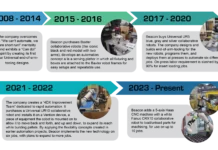by Nick Sotos
iD Additives, Inc.
 In the early 1980s, liquid color acquired a reputation as an unreliable method of coloring thermoplastics, primarily due to the lack of technology involving the carrier and delivery systems. Together with a limited supply base that was largely familiar with manufacturing dry powder and pellet concentrates, liquid color suppliers did not fully cultivate their product or the service required to introduce it to an industry that was starving for new technology – even though it provided an opportunity to reduce cost and improve product quality.
In the early 1980s, liquid color acquired a reputation as an unreliable method of coloring thermoplastics, primarily due to the lack of technology involving the carrier and delivery systems. Together with a limited supply base that was largely familiar with manufacturing dry powder and pellet concentrates, liquid color suppliers did not fully cultivate their product or the service required to introduce it to an industry that was starving for new technology – even though it provided an opportunity to reduce cost and improve product quality.
Advances in technology
Since those archaic times – often referred to as the – dark days of liquid color advancements have been made not only in carrier technology and delivery systems, but also in how the conversion of liquid color is implemented.
Liquid color liquid is pumped into the processing machinery – whether injection molding, blow molding or extrusion – from the product container through a liquid metering pump and into the inter-mixer or directly into the feed throat of the hopper. Today’s gravimetric delivery systems are much more precise, and advancements have been made in metering pumps, mixers and pre-mixers, bucket tumblers and agitators, pump carts, tote delivery systems, adapters, plates and injection nozzles.
In addition to equipment modifications, changes have been implemented in the carrier with which the liquid colorant is mixed. The carriers are more compatible with resin systems, are easier to clean and maintain heat stability without separation.
As the technology has changed to eliminate concerns from the “dark days,” liquid color has seen a surge into new market segments of the plastics industry, from PET bottles, caps and closures to automotive, appliance and cosmetics. Advancements in liquid carrier technology also have found application in the additives side of the plastics industry. Allowing higher component loadings and delivering more evenly dispersed particles in the final application provide advantages over traditional pellet concentrates. Additives such as foaming agents, nucleating and clarifying agents can be delivered in very precise doses to improve both process and part aesthetics.
Benefits of liquid colors and additives
Like any other process improvement, implementing liquid color requires a culture that desires change and handles developments with an organized approach. Because many processors are already familiar with handling conventional pellet concentrates, liquid color can be viewed as an unnecessary change to the process. And, if by chance there is some history that reminds employees of the “dark days,” there may be obstacles to overcome before any consideration is given to the many benefits of change.
Benefits for liquid color include decreased cycle times and environmentally friendly systems. Liquid colors typically allow higher pigment loadings than in typical concentrates, which means less color is required. This, in turn, lowers color costs for the processor. Inventory space is reduced, since liquid color packaging is much more compact than pelletized colorants, and manual labor also sees a reduction, as liquid color delivery equipment eliminates the blending process.
In addition, the packaging of liquid color has been perfected to provide a close-looped system that allows the color to be conveyed to the process equipment without exposure. These delivery systems are precise, easy to use and relatively inexpensive in comparison with the traditional pellet concentrate feeder. Processors often find more homogenous color with liquid, since liquid color can be metered and dosed much more effectively into the plastic melt stream, allowing for better color dispersion and improved part-to-part consistency.
All that said, liquid color is an option for any plastic processor – injection molder, blow molder or extruder – with the desire to implement a change in the process and a culture that will deliver a plan for improvement.
Nick Sotos is founder and president of iD Additives, Inc., LaGrange, Illinois. The company offers lines of foaming agents, liquid systems, purging compounds and additives that will fulfill a majority of customers’ needs. For any additional needs, custom products can be quickly designed. Coupling foaming agent technology with other additive and colorant needs allows iD Additives to offer a cost-effective “One Pellet Solution” for its customers additive needs. For more information, visit www.idadditives.com.




